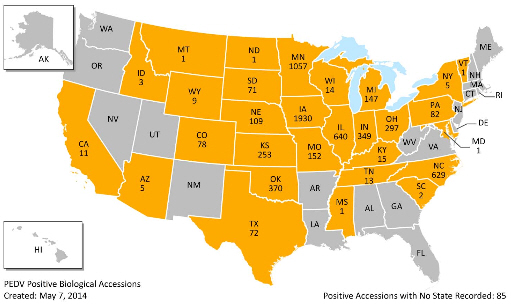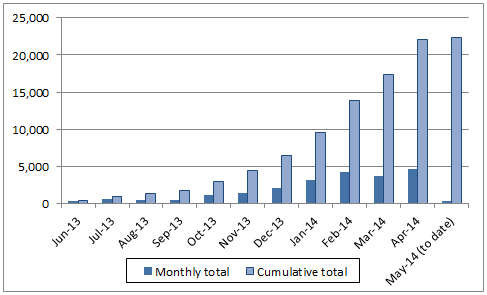



PED Update in US: Iowa Still Most-Affected State
US - The total number of farms that have tested positive for the Porcine Epidemic Diarrhoea (PED) virus now stands at 6,461 in 30 states, writes Jackie Linden.The US National Animal Health Laboratory Network (NAHLN) reports 191 positive accessions out of 801 tested at 10 veterinary diagnostic labs for the week ending 3 May 2014, according to the American Association of Swine Veterinarians (AASV). In addition, NAHLN adjusted the previous week's numbers from 204 positive accessions to 211.
The number of states reported to the NAHLN as having at least one confirmed case of PED remains at 29. AASV is aware, however, that case(s) have also been diagnosed in Virginia, which would bring the actual state count to 30.

Pig Farm Samples Testing Positive for PEDv: 6,421
The total number of pig farm samples (termed 'laboratory biological accessions' in the official report) that have tested positive for the PED virus (PEDv) since April 2013 now stands at 6,421, which includes 1,048 for the month of April and 71 for May so far.
Since testing was fully reported in November 2013, 17,468 farm samples have been tested, of which 31 per cent have tested positive for the virus.

(since April 2013; data from NAHLN)
Results by age class
Suckling pigs
For month of April, 533 farms were tested, of which 228 or 43 per cent were positive for PEDv.
For the current month to date, 51 farms have been tested, of which 23 or 45 per cent were positive for PEDv.
Since testing was fully reported in November 2013, 2,343 farms have been tested, of which 1,366 or 49 per cent tested positive for PEDv.
Nursery pigs
For month of April, 512 farms were tested, of which 177 or 35 per cent were positive for PEDv.
For the current month to date, 46 farms have been tested, of which 14 or 30 per cent were positive for PEDv.
Since testing was fully reported in November 2013, 2,817 farms have been tested, of which 1,183 or 37 per cent tested positive for PEDv.
Grower/finisher pigs
For month of April, 588 farms were tested, of which 121 or 21 per cent were positive for PEDv.
For the current month to date, 52 farms have been tested, of which 10 or 19 per cent were positive for PEDv.
Since testing was fully reported in November 2013, 3,123 farms have been tested, of which 1,199 or 28 per cent tested positive for PEDv.
Sows and boars
For month of April, 362 farms were tested, of which 60 or 17 per cent were positive for PEDv.
For the current month to date, 41 farms have been tested, of which five or 12 per cent tested positive for PEDv.
Since testing was fully reported in November 2013, 1,380 farms have been tested, of which 558 or 29 per cent tested positive for PEDv.
Unknown age class
For month of April, 1,912 farms were tested, of which 483 or 25 per cent were positive for PEDv.
For the current month to date, 150 farms have been tested, of which 25 or 17 per cent tested positive for PEDv.
Since testing was fully reported in November 2013, 8,410farms have been tested, of which 2,273 or 26 per cent tested positive for PEDv.
Results by state
According to AASV, the total number of states affected remains at 30.
The total number of positive accessions on this report (up to the week of 27 April) is 6,421.
Those states with 100 or more positive tests are: Iowa, 1,930; Minnesota, 1,057; Illinois, 640; North Carolina, 629; Oklahoma, 370; Indiana, 349; Ohio, 297; Kansas, 253; Missouri, 152, Michigan, 147 and Nebraska, 109.
For the most recent week (week of 27 April), most of the new cases - 43 of the 191 new positive results - were in Iowa, followed by Minnesota (41) and Illinois (32).
Also reporting one or more positive results were Colorado, Indiana, Michigan, Missouri, North Carolina, Nebraska, Ohio, Oklahoma, South Dakota, Tennessee, Texas and Wyoming.
Pig Samples Testing Positive for PEDv: 22,374
The total number of swine samples (termed 'biological samples' in the official report) since testing began in June 2013 now stands at 22,374.
For the month of April, 22,195 samples weren tested, of which 4,665 or 21 per cent tested positive for PEDv.
For the current month to date, 2,063 samples have been tested, of which 267 or 13 per cent tested positive for PEDv.
Since testing was fully reported in November 2013, 80,678 samples have been tested, of which 22,374 or 24 per cent tested positive for PEDv.

(since June 2013; data from NAHLN)
Environmental Samples Testing Positive for PEDv: 5,227
The total number of environmental samples testing positive since testing began in June 2013 now stands at 5,227.
For the month of April, 4,916 samples were tested, of which 1,380 or 28 per cent tested positive for PEDv.
For the current month to date, 583 samples have been tested, of which 174 or 30 per cent tested positive for PEDv.
Since testing was fully reported in November 2013, 18,430 samples have been tested, of which 26 per cent tested positive.

(since June 2013; data from NAHLN)
Notes on the report
These data are collated by USDA APHIS VS NVSL National Animal Health Laboratory Network (NAHLN) in a report dated 7 May 2014 made available by the Veterinary diagnostic laboratories that have voluntarily reported PEDV testing data to NAHLN include: University of Georgia – Athens, University of Illinois, Iowa State University, Kansas State University, Michigan State University - Diagnostic Center for Population and Animal Health, University of Minnesota, Nebraska Veterinary Diagnostic Center, North Dakota State University, Ohio Department of Agriculture, Oregon State University, Purdue University, South Dakota State University and Texas Veterinary Medical Diagnostic Laboratory. This data does not include testing conducted at private diagnostic laboratories, at the NVSL, or for research purposes.
Data summaries provided in this report reflect the most current and complete data available at the time of report preparation; summaries in this report may differ from those provided in past reports.
PEDv data were collated and summarized by Iowa State University Diagnostic Laboratory from mid-April through mid-June, 2013; only summary data on positive samples are available for that time period. Totals for April 2013 only include testing after 4/16/2013.
NAHLN Laboratories began providing more granular information about PEDv testing starting the week of 6/16/2013, and USDA NAHLN began collating the testing data at that time. During the 2013 federal government shutdown, the University of Minnesota Diagnostic Laboratory collected and reported PEDv testing data (weeks of 9/22/13 through 10/6/13).
Data on PEDv-negative accessions and samples became available from all laboratories starting November 2013. Therefore, summaries “total number tested” and “percent positive” are only calculated for samples tested after November 1, 2013.
In general, a laboratory accession is a set of samples received at the laboratory in which the samples were collected at a single premises on a single day. Therefore, each laboratory accession represents a swine herd and each sample represents an individual animal tested for PEDv on a given date. Because multiple swine within a herd are often simultaneously infected, analyses often use the laboratory accession as the epidemiological unit of interest.
Age classes are defined as suckling (up to one month old or still on sow), nursery (one to three months), grower/finisher (three to eight months) and sow/boar (older than eight months).
A single accession can include samples from multiple age classes or samples tested in different weeks. Therefore, the same accession can be counted in more than one age class category or more than one testing week summary.
This report does not currently include results of testing on feed samples.
This report only includes PCR testing data for PEDv at this time, with additional testing types to be added to the report as information on the performance of new assays becomes available.








